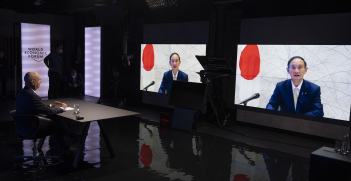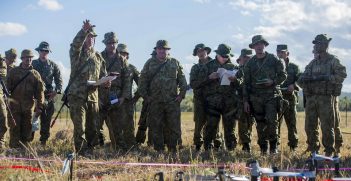Insights from Japan’s Disaster Anniversaries on the Potential Adaptation for Disaster Prevention Parks in the Indo-Pacific

Japan has experienced three major earthquakes in the past 100 years. In an era of frequent natural disasters, Japan’s unique disaster prevention park system has received renewed attention as a means of transmitting disaster memories to the next generation.
In densely populated urban areas of Japan, such as Tokyo and Osaka, which have potential risks of large fires or earthquakes, the development of disaster prevention parks—serving as evacuation sites and routes, firebreaks, and bases for recovery and reconstruction—has become an urgent priority. Introducing natural disaster prevention parks can also be a common challenge for major cities in other Asian countries, where robust disaster prevention policies are increasingly needed.
The mhree massive earthquakes in Japan
Japan is prone to earthquakes and has experienced numerous natural disasters over the years. The impact of the 2011 Great East Japan Earthquake and Tsunami (GEJET) remains etched in the collective memory of the inhabitants of the Indo-Pacific region. The Mj 7.6 Noto Peninsula earthquake of 2024 resulted in 462 people dead or missing. In September, while recovery efforts were underway, the area was also impacted by a heavy rainfall disaster. Consequently, reconstruction and restoration have yet to make significant progress. It is now over a century since the 1923 Great Kanto Earthquake (GKE), 20 years since the 2004 Sumatra-Andaman Earthquake, and 30 years since the 1995 Great Hanshin-Awaji Earthquake (GHAE)—events where a violent tremor with a maximum intensity of 7 struck the city early in the morning, causing buildings to collapse and resulting in the loss of 6,434 lives. At the time, the earthquake was considered the worst disaster in post-war history.
Each earthquake differs in scale, type, location, timing, and societal context, resulting in vastly different patterns of damage and lessons learned. For instance, during the GKE, 90 percent of fatalities resulted from fires, compared to approximately 80 percent of deaths caused by being crushed under collapsed buildings or furniture in the GHAE. Fatalities from the 2004 Sumatra-Andaman Earthquake were predominantly due to injuries from the tsunami, while over 90 percent of deaths in the GEJET were from tsunami-induced drowning.
The importance of places for disaster memory transmission to future generations
In December 2004, a devastating earthquake rocked Indonesia. In Aceh province, near the epicentre, over 160,000 people lost their lives. Over two decades later, as of 2025, Aceh’s population has returned to pre-disaster levels (approximately 260,000), though Aceh’s population is now qualitatively different, comprising a younger generation born after the earthquake, as well as migrants from elsewhere in Indonesia. The challenge is that, unless measures are taken, the proportion of residents who have experienced or can discuss past tsunamis will decrease in the affected areas of Aceh in the future. This reflects a broader challenge across Asia, including Japan: how can disaster memory transmission and lessons of disasters be preserved for future generations?
In Japan, only a handful of people remain who can personally recount their experiences of the GKE, which occurred just over 100 years ago. With a 70 percent probability of a major earthquake striking directly beneath Tokyo in the next 30 years, how can we apply and transmit the disaster lessons of the past century to better prepare for the future?
In post-earthquake disaster areas across Asia, annual post-disaster memorial ceremonies have long been held on the anniversaries of such events. These areas are often reconstructed as memorial places, monument sites, or parks, and designated as special places of remembrance. However, few of these spaces are established with the intention not only to memorialise past tragedies, but also to actively convey disaster memories and lessons to emerging generations.
Before becoming remembrance or disaster ritual sites, what existed in these post-disaster places? How these areas are preserved after natural disasters can profoundly shape the lessons conveyed to us today. The contributions of these disaster-affected places as a means of disaster transmission explore the processes and lessons behind the creation of ritual spaces related to earthquakes in Japan, focusing on how these spaces evolve and the stories they tell.
Open spaces and fires during earthquakes: lessons from Japan
As a country prone to natural disasters, Japan provides valuable disaster policies and case studies to the world. However, in many of these cases, lessons were not learned, resulting in the same mistakes being repeated in subsequent disasters or the recurrence of similar damage as before. One such example is the GHAE, where the same mistakes from the GKE were repeated. One major issue was the damage caused by simultaneous fires.
In the GKE, the majority of deaths were caused by firestorms. Today, Tokyo Metropolitan Yokoamicho Park serves as a memorial and education park, but, during the time of the GKE, it was an open space at the site of a former military uniform factory. Many people evacuated to this place with their household goods, and the strong winds from a passing typhoon spread embers to these items, causing a massive fire tornado. As a result, many perished in the flames, with an estimated 38,000 deaths and only 20,000 survivors.
During the GHAE, despite it being winter and there being relatively weak winds, the city’s dense wooden structures contributed to simultaneous fires that exceeded firefighting capacity. While people fled to parks and other open spaces, many still lost their lives for reasons similar to those in the GKE. One contributing factor was the post-WWII “peace-blindness.” While it seems that the lessons of the GKE were initially passed down, after the 1959 Ise Bay Typhoon, which led to the establishment of Japan’s Basic Act on Disaster Management, the country experienced a long period without major disasters. During this time, post-war reconstruction became the country’s top priority. Urban planning prioritised economic development and catching up with the West over disaster prevention and mitigation. Thus the nation was unprepared for the devastation of the GHAE.
Greenery power for urban disaster prevention
During the GHAE, some parks halted the spread of fire. In Daikoku Park in Kobe City, nearly 30 camphor trees, which contain water, acted as a “water wall” to prevent the spread of fire and served as an important base for subsequent rescue activities. The difference between the GKE and the GHAE is that the level of simultaneous fires was at the city level during the former but at the district level in the latter. This was due to the effectiveness of urban fire protection zones demarcated by arterial roads and burn-blocking zones. In addition, the establishment of the Disaster Prevention Park Project in 1978 also seems to have had an impact. After the GHAE, the lessons learned from the GKE were reviewed, and the need for wide-area evacuation sites to accommodate evacuees was reaffirmed. Subsequently, during the 2004 Niigata Chuetsu Earthquake and the GEJET, parks were used as gathering points for the Self-Defense Forces, police, and fire departments, as well as locations for restoration support activities. The demonstrated success of this plan ultimately led to the expansion of the development of disaster prevention parks in Japan.
A place to transmit disaster lessons to future generations
At the Hill of Millennium Hope Park in Iwanuma City, which was damaged by the GEJET, the park’s Exchange Centre presents GEJET records and memories by showing educational videos of the disaster and recovery in several languages, as well as environmental conservation activities as tree planting and raising. Visitors can also experience the area’s recovery and reconstruction thanks to volunteer guides who share stories about the earthquake in the disaster memorial park.
Higashimachi Park (Tsubame City), which began service in April 2015, is based on the concept of a park where people can learn about disaster prevention, and is equipped with six types of disaster prevention facilities. This park is used by residents for recreation, but it also raises disaster awareness among visitors by combining local evacuation drills with tours of disaster-prevention facilities. These facilities include: a pergola that can be used as a bath; a toilet stool; a disaster-prevention arbour with storage on a porch; an observatory with a stockpile warehouse; a kamado (a traditional Japanese wood-/charcoal-fuelled cook stove) bench; and a disaster-prevention storage bench. Users have commented that tours of the disaster prevention facilities made them realise the importance of securing toilets, stoves, and bathrooms in the event of a disaster.
Future remarks
Parks are usually recognised as places of recreation and as open spaces where people can heal their bodies and minds, and maintain and improve their health. However, in Asia, where natural disasters frequently occur, urban planning and policies must ensure they adhere to certain levels of safety, including that they can be used as effective refuge zones.
Japan has experienced three major earthquakes in the past 100 years, each time drawing attention to the role of disaster prevention and mitigation in controlling the spread of fires, creating evacuation zones, and forming bases for rescue, relief, and recovery efforts. This is a precedent that will be highly useful in Asian countries, where natural disasters are becoming increasingly frequent and severe due to factors including climate change and increasing urbanisation.
However, the system of disaster prevention parks is unique to Japan and is not well known worldwide. In the future, earthquake disaster memorial sites in Asian countries should be regenerated as “disaster prevention parks” that prevent and mitigate natural disasters, and help spread the lessons learned to future generations in the Indo-Pacific. I hope that Japan’s “Disaster Reduction Park” policy will form a core part of Green Infrastructure and Eco-DRR, which are being considered for disaster reduction policies in various countries, including Australia, Fiji, and Indonesia. If the goals in the Sendai Framework for Disaster Risk Reduction were achieved, the disaster prevention park systems could be expanded and integrated into a disaster prevention or mitigation policy for the wider Asian region. In this natural disaster-prone century, it is my sincere hope that disaster prevention parks play a positive role in helping those affected both during and after disasters.
Ai Tashiro is an associate professor at the Graduate School of Human and Environmental Studies, Kyoto University. She was a 2023-2024 cohort member of the AIIA fellow program of the Indo-Pacific Cooperation Network (AIIA-IPCN) in the field of disaster resilience.
This article is published under a Creative Commons License and may be republished with attribution.





